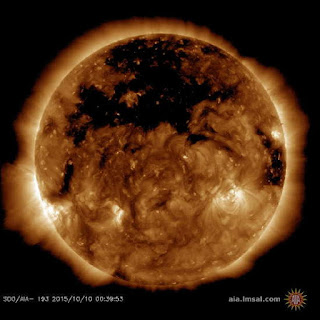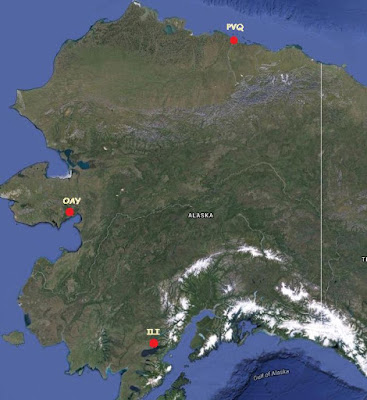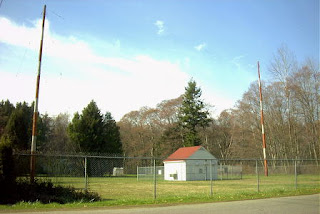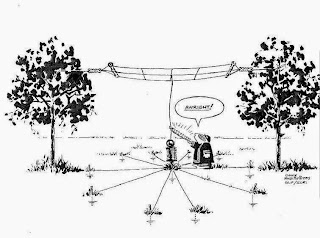Posts Tagged ‘MF’
 Another 630m Crossband Weekend
Another 630m Crossband Weekend
 Fritz Raab (W1FR), the ARRL's 600m Experiment Coordinator, has indicated that this year's '630m Special Operating Event' will be held on the weekend of November 13 / 14. Mark your calendars if you plan to participate as it looks as though, once again, along with the numerous U.S. experimental stations beaconing and coastal maritime stations, several Canadian 630m stations will be active and looking for realtime CW 'crossband' contacts! Canadian stations will 'CQ' on specific frequencies and will listen for calling stations on designated HF (80/40m) answering (QRSS) frequencies.
Fritz Raab (W1FR), the ARRL's 600m Experiment Coordinator, has indicated that this year's '630m Special Operating Event' will be held on the weekend of November 13 / 14. Mark your calendars if you plan to participate as it looks as though, once again, along with the numerous U.S. experimental stations beaconing and coastal maritime stations, several Canadian 630m stations will be active and looking for realtime CW 'crossband' contacts! Canadian stations will 'CQ' on specific frequencies and will listen for calling stations on designated HF (80/40m) answering (QRSS) frequencies.Unlike last year, the Canadian stations will be operating for several hours on both nights, since there will be no conflict with the ARRL's CW Sweepstakes Contest as in 2014. Please stay tuned as there will be further details to follow regarding specific stations, frequencies and times ... notifications will be published on both the ARRL and RAC web 'news' pages as well as on numerous ham radio reflectors.
There's still lots of time to tweak up your 630m receiving capabilities ... it should be an interesting weekend, especially if the mid-November propagation cooperates.
A summary of last year's Friday night crossband activity can be found here.
 LF Improving
LF Improving
 |
| courtesy: http://sdo.gsfc.nasa.gov/ |
After more than a week of horrendous geomagnetic activity, due mainly to coronal-hole streaming, it looks as if things are starting to settle down once again. One would never know it from looking at the sun's image as the source of the streaming is largely invisible in the visible light spectrum. Viewing at a different wavelength however, reveals the source of the disruption, now about to rotate out of view for a few weeks.
 |
| courtesy: http://sdo.gsfc.nasa.gov/ |
 |
| courtesy: http://wdc.kugi.kyoto-u.ac.jp/dst_realtime/presentmonth/index.html |
 |
| courtesy: http://www.noaa.gov/ |
 Alaskan NDBs Awaken
Alaskan NDBs Awaken

Good geomagnetically-quiet conditions continued into Tuesday morning, with the 'K' index hitting '0' just before dawn here on the west coast. A two-minute Perseus recording of the NDB band revealed good propagation towards Alaska, the first of the season.
The first good opening of the new DX season always provides an opportunity to see which NDB's have survived the summer and have not been closed down by the FAA bean counters. Every year, a few more of the Alaskan NDBs go quiet, with no new ones being added to the list.
The situation is certainly not confined to Alaska. The growing reliance on GPS and RNAV procedures is gradually making the reliance on NDBs a thing of the past. Frankly I'm astounded, yet grateful, that there are many hundreds of NDBs still in use and I'll really miss chasing the low-powered DX targets when they are all eventually decommissioned.
The following Alaskans were heard on Tuesday morning at 1300Z, about one hour before my local sunrise:
9/30/15 1300 529 SQM Level Island AK CO36
9/30/15 1300 396 CMJ Ketchikan AK CO45
9/30/15 1300 391 EEF Sisters Island AK CO28
9/30/15 1300 372 FPN Fredericks Point AK CO36
9/30/15 1300 266 ICK Annette Island AK CO45
9/30/15 1300 414 IME Mt. Edgecumbe AK CO27
9/30/15 1300 394 RWO Kodiak AK BO37
9/30/15 1300 209 CYT Yakataga AK BP80
9/30/15 1300 390 HBT Sand Point AK AO95
9/30/15 1300 358 SIT Sitka AK CO26
9/30/15 1300 350 VTR McGrath AK BP22
9/30/15 1300 338 CMQ Campbell Lake AK BP41
9/30/15 1300 429 BTS Dillingham AK BO08
9/30/15 1300 233 ALJ Johnstone Point AK BP60
9/30/15 1300 212 CGL Coghlan Island AK CO28
9/30/15 1300 223 AFE Kake AK CO36
9/30/15 1300 229 AKW Klawock AK CO35
9/30/15 1300 283 DUT Dutch Harbor AK AO63
9/30/15 1300 245 HNS Haines AK CO29
9/30/15 1300 347 DJN Delta Junction AK BP74
9/30/15 1300 411 ILI Iliama AK BO29
9/30/15 1300 277 ACE Homer AK BO49
9/30/15 1300 355 AUB King Salmon AK BO18
9/30/15 1300 524 MNL Valdez AK BP61
9/30/15 1300 382 JNR Unalakleet AK AP93
9/30/15 1300 281 CRN Cairn Mountain AK BP21
9/30/15 1300 385 EHM Cape Newenham AK AO88
9/30/15 1300 385 OCC Yakutat AK CO09
9/30/15 1300 263 OAY Norton Bay AK AP84
9/30/15 1300 390 AES Northway AK BP29
9/30/15 1300 404 GCR Cordova AK BP70
9/30/15 1300 525 ICW Nenana AK BP54
9/30/15 1300 251 OSE Bethel AK AP90
9/30/15 1300 341 ELF Cold Bay AK AO85
9/30/15 1300 248 GLA Gulkana AK BP72
9/30/15 1300 376 PVQ Deadhorse AK BQ50
9/30/15 1300 379 IWW Kenai AK BP40
9/30/15 1300 399 SRI St. George AK AO56
9/30/15 1300 359 ANI Aniak AK BP01
9/30/15 1300 272 UTO Utopia Creek AK BP35
9/30/15 1300 275 CZF Cape Romanzof AK AP61
9/30/15 1300 529 FDV Nome AK AP74
9/30/15 1300 391 EAV Bettles AK BP46
9/30/15 1300 346 OLT Soldotna AK BP40
9/30/15 1300 347 TNC Tin City AK AP65
There were several missing from the list ... but I classify them as 'third-tier' beacons since propagation needs to be even better than it was on Tuesday to hear them. These are beacons that are either suffering from terrible locations, small inefficient antenna / ground systems or in need of maintenance. I also have a list of Alaskans that have never been heard at all outside of Alaska but are known to be on the air according to recent FAA online information. It is these last two groups that keep me watching and waiting ... for those magic mornings that happen only once or twice per year.
From what I can surmise by scouring the FAA information, there are presently 77 active NDBs in Alaska, including the ones not heard down here. If you live in Alaska, and can take a listen on the NDB band, I'll send you the ones I'm not sure about. If anyone else wants a list of all of the beacons up there, with detailed frequency information, drop me an e-mail and I will send you a three-page pdf.
Here are some signal samples, recorded on Tuesday morning, of some of the 'second-tier' (not heard every morning) signals from Alaska.
 |
| courtesy: https://www.google.ca/maps |
PVQ - 376 kHz Put River (Deadhorse), Alaska
OAY - 263 kHz Norton Bay (Moses Point), Alaska
ILI - 411 kHz Iliamna, Alaska
With the sun getting quieter and quieter, conditions on the NDB band should continue to get better and better over the next several years ... let's just hope that the NDBs are still around long enough to enjoy the solar-quiet benefits.
 Conditions Rising
Conditions Rising
Conditions towards the east on LF as well as on the broadcast band (BCB) have taken a positive leap forward over the past few days. Last night, 160m was open to Europe from here, the first opening of the season as far as I am aware. I also spent some time listening to a dozen or more TA (Trans-Atlantic) carriers on the broadcast band, signalling good conditions over the pole finally.The polar skip also extended down into the LF band, as it did the previous night.
In the afternoon hours I started watching for Europe1 on 183kHz, transmitting from western Germany, and was able to see its weak carrier on the Perseus SDR's waterfall display several hours before sunset. Twilight here brought a dramatic improvement in signal strength as shown below.
As daylight approached the transmitter site in Germany, the 183kHz signal provided a good visual example of 'dawn-enhancement', with the signal showing a dramatic flare on the waterfall indicating its build-up in strength.
Once dawn arrived, it was interesting to see that the signal was able to hang-on for over an hour with reasonable strength before fading out rather quickly. Even though the transmitter site was in full daylight, the dark skies to the west were able to sustain propagation for some time before it all came crashing down.
Of late, the pre-dawn hours here have also been providing some exceptionally strong signals from Asia on the BCB. These are often enhanced at sunrise as well, as the strength often takes a short fast peak, before fading out for the day.
One of the loudest this week was from JOAK (NHK1) in Tokyo on 594 kHz ... listen ...
This was heard on the Perseus SDR and inverted-L antenna. The LF polar signals shown above, were recorded with the 10' X 20' loop and Wellbrook preamp while looping towards Europe at 030 degrees.
With the DST going positive, hopefully these good conditions will continue to build over the next few weeks. October is often one of the best months of the year for LF/MF DX.
In the afternoon hours I started watching for Europe1 on 183kHz, transmitting from western Germany, and was able to see its weak carrier on the Perseus SDR's waterfall display several hours before sunset. Twilight here brought a dramatic improvement in signal strength as shown below.
As daylight approached the transmitter site in Germany, the 183kHz signal provided a good visual example of 'dawn-enhancement', with the signal showing a dramatic flare on the waterfall indicating its build-up in strength.
Once dawn arrived, it was interesting to see that the signal was able to hang-on for over an hour with reasonable strength before fading out rather quickly. Even though the transmitter site was in full daylight, the dark skies to the west were able to sustain propagation for some time before it all came crashing down.
Of late, the pre-dawn hours here have also been providing some exceptionally strong signals from Asia on the BCB. These are often enhanced at sunrise as well, as the strength often takes a short fast peak, before fading out for the day.
One of the loudest this week was from JOAK (NHK1) in Tokyo on 594 kHz ... listen ...
This was heard on the Perseus SDR and inverted-L antenna. The LF polar signals shown above, were recorded with the 10' X 20' loop and Wellbrook preamp while looping towards Europe at 030 degrees.
With the DST going positive, hopefully these good conditions will continue to build over the next few weeks. October is often one of the best months of the year for LF/MF DX.
 |
| courtesy: http://wdc.kugi.kyoto-u.ac.jp/dst_realtime/presentmonth/index.html |
 CLE 198 Results
CLE 198 Results
 |
| courtesy: http://www.swpc.noaa.gov/ |
For those looking to log Hawaii on the NDB band, 'POA' on 332 kHz is a good bet as it had a strong signal here on all three nights and was heard shortly after sunset in Hawaii.
------------------------------------------------------------------------------------
DD UTC kHz Call mi New Location
--------------------------------------------------------------------------------
19 11:00 323 HJH 1393 Hebron Municipal Apt, NE, USA
19 10:00 325 YJQ 312 Bella Bella (Campbell Island), BC, CAN
19 12:00 326 XJ 522 Fort St. John, BC, CAN
19 09:00 326 MA 1594 FARLY - Midland, TX, USA
20 04:00 326 FO 1531 'Riply' Topeka, KS, USA
19 10:00 326 DC 131 Princeton Municipal Apt, BC, CAN
19 12:00 328 LAC 133 'Lacomas' Fort Lewis, WA, USA
19 12:00 328 5J 564 Coronation, AB, CAN
20 05:00 329 YHN 1730 Hornepayne, ON, CAN
19 12:00 329 YEK 1414 Arviat, NU, CAN
19 12:00 329 X2 590 Athabasca, AB, CAN
19 12:00 329 TAD 1240 Trinidad - Hoehne, CO, USA
19 10:00 329 PMV 1437 Plattsmouth, NE, USA
19 12:00 329 PJ 920 Robinson (Whitehorse), YT, CAN
21 09:00 329 HMA 1851 Hondo Municipal Apt, TX, USA
19 08:00 332 XT 442 Terrace, BC, CAN
19 08:00 332 XH 565 Medicine Hat, AB, CAN
19 08:00 332 WC 25 White Rock (Abbotsford), BC, CAN
20 04:00 332 VVV 1280 Ortonville Municipal Apt, MN, USA
19 08:00 332 POA 2681 Pahoa - Hawaii Island, HWA
20 05:00 332 FIS 2794 Fish Hook - Key West, FL, USA
19 08:00 333 STI 540 'Sturgeon' Mountain Home, ID, USA
19 08:00 334 P2 514 Wetaskiwin, AB, CAN
------------------------------------------------------------------------------------
As usual, all stations were heard using the Perseus SDR.
Hopefully CLE 199 will see the return of quieter band conditions and better propagation ... if the sun can calm down long enough.
 Hunting For NDBs In CLE 198
Hunting For NDBs In CLE 198
 |
| 'WC' - 332 kHz White Rock, B.C. |
A list of all of the North American targets in this range can be found in the RNA database, while targets for European DXers will be found here ... specify the frequency range wanted and check 'show all results'.
An excellent target for this CLE is 'WC' (332kHz) shown here. Its 25W signal gets out very well and has been heard as far as Texas. It is unusually-located in the middle of a quiet residential street, nestled between homes on each side.
From CLE coordinator Brian Keyte (G3SIA) comes the following reminder:
Our next Co-ordinated Listening Event is less than a week away.
It is an ideal one for new listeners as well as for regulars:
Days: Friday 18 September - Monday 21 September
(a week earlier than originally planned)
Times: Start and End at midday, your LOCAL time
Range: 320.0 - 334.9 kHz
It's straightforward - just log the NDBs that you can identify having their
nominal frequencies in the range, plus any UNIDs that you come across
there. We last concentrated on these frequencies during CLE183 in June
2014.
We'll be near the DGPS beacons range and some of us, especially in North
America, may hear a few. I suggest that we don't seek out or report these
in this CLE.
Send your CLE log to the List, if possible as a plain text email and
not in an attachment, with CLE198 at the start of its title.
Show on EVERY LINE of your log:
# The Date (or day 'dd') and UTC (the day changes at 00:00 UTC).
# kHz - the beacon's nominal published frequency (if you know it).
# The Call Ident.
Please show those main items FIRST on each line, then any optional details
such as Location, Offsets, Distance, etc.
If you send interim logs, do make sure that you also send a 'Final' log
containing all your loggings. As always, please make your log useful and
interesting to everyone by including your own location and brief details
of your receiver, aerial(s) and any recording equipment that you used.
You can find CLE-related information from the CLE page,
http://www.ndblist.info/cle.htm , including access to the seeklists
that have been made for the event from REU/RNA/RWW.
(NB: To also see a MAP of the seeklist NDBs around you, just change
'List' to 'Map', select 'All Results' and uncheck 'Clustering')
Good listening
Brian
----------------------------------------------------------
From: Brian Keyte G3SIA ndbcle'at'gmail.com
Location: Surrey, SE England (CLE co-ordinator)
----------------------------------------------------------
(Reminder: You could use any one remote receiver for your loggings,
stating its location and owner - with their permission if required.
A remote listener may NOT also use another receiver, whether local or
remote, to obtain further loggings for the same CLE).
It is an ideal one for new listeners as well as for regulars:
Days: Friday 18 September - Monday 21 September
(a week earlier than originally planned)
Times: Start and End at midday, your LOCAL time
Range: 320.0 - 334.9 kHz
It's straightforward - just log the NDBs that you can identify having their
nominal frequencies in the range, plus any UNIDs that you come across
there. We last concentrated on these frequencies during CLE183 in June
2014.
We'll be near the DGPS beacons range and some of us, especially in North
America, may hear a few. I suggest that we don't seek out or report these
in this CLE.
Send your CLE log to the List, if possible as a plain text email and
not in an attachment, with CLE198 at the start of its title.
Show on EVERY LINE of your log:
# The Date (or day 'dd') and UTC (the day changes at 00:00 UTC).
# kHz - the beacon's nominal published frequency (if you know it).
# The Call Ident.
Please show those main items FIRST on each line, then any optional details
such as Location, Offsets, Distance, etc.
If you send interim logs, do make sure that you also send a 'Final' log
containing all your loggings. As always, please make your log useful and
interesting to everyone by including your own location and brief details
of your receiver, aerial(s) and any recording equipment that you used.
You can find CLE-related information from the CLE page,
http://www.ndblist.info/cle.htm , including access to the seeklists
that have been made for the event from REU/RNA/RWW.
(NB: To also see a MAP of the seeklist NDBs around you, just change
'List' to 'Map', select 'All Results' and uncheck 'Clustering')
Good listening
Brian
----------------------------------------------------------
From: Brian Keyte G3SIA ndbcle'at'gmail.com
Location: Surrey, SE England (CLE co-ordinator)
----------------------------------------------------------
(Reminder: You could use any one remote receiver for your loggings,
stating its location and owner - with their permission if required.
A remote listener may NOT also use another receiver, whether local or
remote, to obtain further loggings for the same CLE).
These listening events serve several purposes. They:
- determine, worldwide, which beacons are actually in service and on-the-air so the online database can be kept up-to-date
- determine, worldwide, which beacons are out-of-service or have gone silent since the last CLE covering this range
- will indicate the state of propagation conditions at the various participant locations
- will give you an indication of how well your LF/MF receiving system is working
- give participants a fun yet challenging activity to keep their listening skills honed
Final details can be found at the NDB List website, and worldwide results, for every participant, will be posted there a few days after the event. If you are a member of the ndblist Group, results will also be e-mailed and posted there.
The very active Yahoo ndblist Group is a great place to learn more about the 'Art of NDB DXing' or to meet other listeners in your region. There is a lot of good information available there and new members are always very welcome.
If you are contemplating getting started on 630m, listening for NDBs is an excellent way to test out your receive capabilities as there are several NDBs located near this part of the spectrum.
You need not be an ndblist member to participate in the CLEs and all reports, no matter how small, are of much value to the organizers. 'First-time' logs are always VERY welcome!
Reports may be sent to the ndblist or e-mailed to either myself or CLE co-ordinator, Brian Keyte (G3SIA), whose address appears above.
Please ... give the CLE a try ... then let us know what NDB's can be heard from your location! Your report can then be added to the worldwide database to help keep it up-to-date.
 LF/MF Moving Closer For U.S. Amateurs
LF/MF Moving Closer For U.S. Amateurs
With all commentary periods for the FCC's 'Notice of Proposed Rulemaking' (Docket 15-99) now closed, it appears that one of the last comments to be filed may contain the most powerful arguments in favor of swift implementation.
In its extremely detailed 42-paged submission, the ARRL states, in no uncertain terms, the reasons why access to both the 2200m LF band and the 630m MF band should not be held back and that service rules should be 'finalized'. Indeed the powerful arguments stated in favor of implementation should go a long way in making this happen sooner rather than later.
The FCC's position is that there is little to no evidence to indicate that amateur radio operation on either band would be incompatible with power company PLC systems, going as far as stating that at distances of 1km or more from PLC lines, "there is no chance of interference". Further supporting their claim, the thousands of hours of experimental operation were offered as powerful proof and that the ARRL was “unaware of any reports of interference to PLC systems arising from that operation conducted pursuant to numerous Part 5 experimental licenses…in the large band utilized by PLCs.”
In addition, the ARRL had harsh words regarding the FCC's attempt to legitimize the growing number of fish-net beacons in the 160m band, and pulled no punches regarding their position in this matter.
"There is no indication that these buoys are compatible with other uses in the band, no track record of interference avoidance or resolution, and certainly no indication that the current operators can be relied on for compliance with the Commission’s rules."
"The Commission is urged to avoid enacting rules that it has no effective ability or intention to enforce. That fishing vessels have, with impunity, illegally deployed radio buoys in this band on a widespread basis (whether or not due to misrepresentations of the importers and retailers of these devices or due to a disregard of the Commission’s rules generally) without even nominal enforcement actions by the Commission, provides no basis for assuming that there will be compliance with any deployment limitations (including geographic deployment restrictions) on these buoys going forward. Nor is there any basis for the assumption that there will be any enforcement action taken with respect to continued illegal operation of the buoys if and when interference is caused. Spectrum planning by the Commission in this context has to be based on ex ante determinations of compatibility rather than mere assumptions, especially where the record indicates such a low level of historical compliance."
A summary of the comments can be read here in the ARRL News while all comments filed for the NPRM be found here temporarily, while the FCC site is down for maintenance.



















